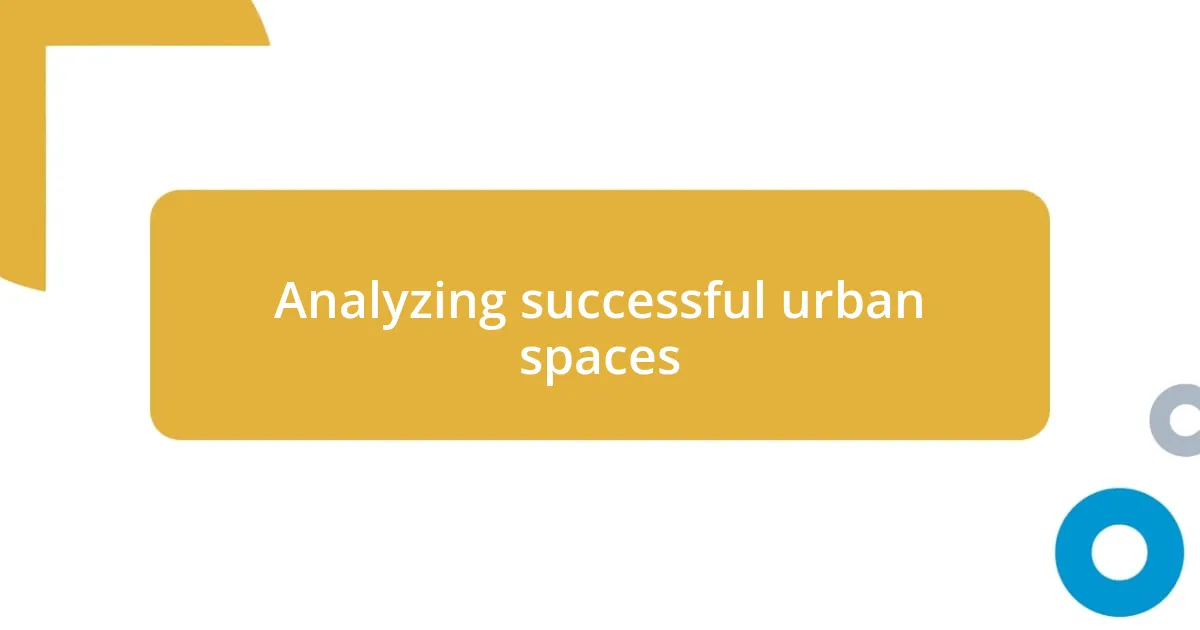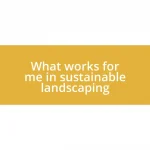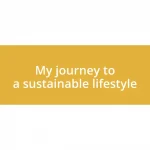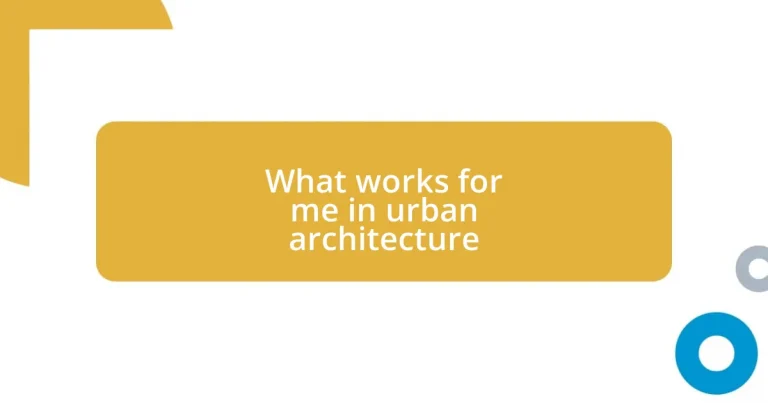Key takeaways:
- Urban architecture integrates function and form, promoting daily life enhancement through well-planned spaces like mixed-use developments.
- Sustainability is vital in urban design, with features like green spaces and renewable energy sources fostering environmental harmony and community well-being.
- Community feedback is essential in shaping urban spaces, creating a sense of ownership and responsive design that meets local needs.
- Inclusive environments prioritize accessibility and cultural diversity, ensuring all community members feel welcome and engaged.

Understanding urban architecture principles
One of the foundational principles of urban architecture is the integration of function and form. I remember walking through a vibrant city district, noticing how every building seemed to have its purpose—shops on the ground floor, offices above. This seamless blend made me think: how does a city design itself to enhance daily life?
Scale is another critical aspect I’ve come to appreciate. When I stand in a grand plaza surrounded by towering structures, I feel a mix of awe and intimacy. It raises the question, “What does scale mean for community interaction?” Larger spaces can ignite social connections, while smaller, cozy areas invite personal conversations—both are essential to urban life.
Then there’s the principle of sustainability, which weighs heavily on my mind. I once stood in a park filled with native plants, realizing how these choices reflect a commitment to the environment. This prompts me to ask: can urban architecture truly harmonize with nature? Effective design does more than just accommodate people; it enriches our surroundings while preserving biodiversity, making cities not just liveable, but also thriving ecosystems.

Identifying personal design preferences
Identifying my personal design preferences has been a journey shaped by experiences and observations. I often find myself drawn to designs that emphasize natural light—there’s something magical about a space that feels alive with sunlight filtering through expansive windows. I recall visiting a beautiful art gallery where the architecture played a crucial role in showcasing the artwork; the open layout bathed in light made each piece resonate differently, stirring emotions I didn’t anticipate.
As I explore different urban settings, I’ve noticed a strong inclination toward vibrant colors and textures. There was a street market I once wandered through, filled with bright murals and eclectic stalls. This experience taught me that the right colors can evoke joy and energy, transforming an ordinary street into a lively thoroughfare. Such elements remind me that architecture doesn’t merely exist; it interacts with those who inhabit the space, influencing our moods and experiences.
Another layer of my preferences lies in how public spaces facilitate community engagement. I recall sitting in a park designed for gatherings, surrounded by families and friends sharing moments together. This experience solidified my belief that well-designed spaces encourage social interactions, fostering connections between people. It prompts me to think: how do different urban designs nurture community bonds?
| Design Element | Personal Preference |
|---|---|
| Natural Light | Essential for ambiance and mood |
| Colors & Textures | Evokes energy and joy |
| Public Spaces | Encourage social interaction |

Analyzing successful urban spaces
Exploring successful urban spaces has revealed to me how thoughtful design can create vibrant communities. I once spent an afternoon in a neighborhood known for its pedestrian-friendly layout, where wide sidewalks and tree-lined streets invited leisurely strolls. There’s something invigorating about walking through a space where the flow feels natural and welcoming—I felt as if the city was encouraging me to engage with it, a powerful reminder of how architecture can shape our experiences.
When analyzing successful urban environments, I find certain characteristics consistently stand out:
– Accessibility: Walkable streets and public transport options allow everyone to connect easily.
– Mixed-use Development: A combination of residential, commercial, and recreational spaces fosters a sense of community.
– Green Spaces: Parks and community gardens not only enhance aesthetics but also promote well-being and biodiversity.
– Cultural Elements: Murals, performance spaces, and outdoor markets create a unique identity that resonates with residents.
– Flexibility: Spaces that adapt to various activities ensure long-term relevance and engagement.
Reflecting on these aspects, I recall a vibrant waterfront area where pop-up events and local markets transformed the space, making it a lively hub of activity. This versatility made it clear to me that great urban design is not static; it evolves and thrives through human interaction.

Applying sustainable urban design
Applying sustainable urban design goes beyond just the aesthetics; it’s about crafting environments that care for the planet and enhance our lives. One memorable weekend, I visited a community built around eco-friendly principles. The greenery was not an afterthought; it was integrated into the architecture, with rooftop gardens and rainwater harvesting systems visible everywhere. Walking through that neighborhood, I couldn’t help but feel a sense of harmony between the buildings and nature. It made me wonder: how can sustainable practices become a standard rather than an exception?
I also think about my experience in a city that prioritized pedestrian pathways over vehicles. The sidewalks were lined with native plants, creating not only beauty but also supporting local wildlife. I loved discovering small pop-up shops that embraced zero-waste principles. It felt empowering to see how urban design could promote sustainability while also strengthening the local economy. This leads me to an important realization: when we design cities to foster ecological practices, we also sow the seeds for vibrant communities.
Reflecting on my travels, there’s something particularly striking about urban spaces that incorporate renewable energy sources—like solar panels seamlessly woven into the architecture. I once admired a building that transformed sunlight into energy while providing shelter. It made me think about the potential for innovation in our cities. Imagine if every new development included elements that harness the power of nature! Wouldn’t it be incredible to live in a place where sustainability is effortlessly woven into our daily lives?

Incorporating community feedback
In my experience, incorporating community feedback into urban architecture can be transformative. I remember attending a town hall meeting where neighbors passionately shared their thoughts on a proposed park redesign. The genuine enthusiasm in the room was infectious; it made me realize that local insights are invaluable, often revealing needs and desires that planners might overlook. What better way to ensure a space is truly beneficial than to involve the very people who will use it?
I’ve witnessed firsthand how community feedback can reshape projects. A neighborhood initiative I participated in showcased residents’ ideas for public spaces, ultimately leading to a volunteer-led community garden. This garden became a gathering point, not just for growing vegetables but for building connections. It’s fascinating how such grassroots involvement creates not only a physical space, but a sense of ownership among residents—don’t you think people care more for places they helped create?
Reflecting on these experiences, I believe that the more we listen to our communities, the stronger our urban environments become. When architects and planners take the time to engage with residents, magic happens. Urban spaces morph from empty designs into vibrant reflections of the people who inhabit them. Isn’t it remarkable how a simple conversation can lead to a profound impact on our shared spaces?

Maximizing functionality in layouts
Maximizing functionality in layouts is crucial for creating spaces that work hard for their inhabitants. I once walked through a mixed-use development where residential units were cleverly positioned above retail spaces. This layout didn’t just save space; it encouraged a vibrant community life. Imagine the convenience of grabbing your morning coffee without leaving home—what a delightful way to start the day!
During another visit, I encountered a co-housing project where common areas were designed to facilitate interaction among residents. The arrangement included a spacious kitchen and dining area centrally located, drawing everyone together for shared meals. It struck me how these designs didn’t just optimize space; they cultivated relationships, fostering a sense of belonging. Isn’t it amazing how thoughtful layouts can transform interactions and enhance our day-to-day experiences?
I’ve also discovered that flexibility in design plays an essential role. In a community center I frequented, movable partitions allowed for varying room sizes depending on the event—whether it was a yoga class or a neighborhood meeting. This adaptability made the space immensely popular, illustrating that layouts should anticipate and accommodate diverse needs. Could it be that the best urban spaces are those that evolve alongside the communities they serve?

Creating inclusive urban environments
Creating inclusive urban environments truly begins with understanding the diverse needs of the community. I recall visiting a public plaza where seating was designed with various heights and styles, catering to everyone from children to elders. It struck me how thoughtful design can create a welcoming atmosphere, inviting people to linger and connect. Wouldn’t you agree that when a space considers all users, it feels more like home to everyone involved?
Moreover, accessibility is central to inclusivity. I remember exploring a neighborhood that had recently installed wide, smooth pathways and curb cuts, making it easy for people with mobility challenges to navigate. Watching families push strollers and individuals with wheelchairs glide along reminded me of the importance of equal access; it’s not just about compliance but creating genuine opportunities for all to participate. Can we envision an urban landscape where everyone can easily enjoy public spaces without barriers?
Fostering a sense of belonging also means embracing cultural diversity. At a community festival I attended, various art installations showcased different cultural heritages, allowing people to share their stories and experiences. The vibrant mix of languages and colors filled the air with energy, demonstrating how urban environments can celebrate our differences. Isn’t it fascinating how the inclusion of varied cultural expressions can turn ordinary spaces into extraordinary ones that resonate deeply with everyone?














